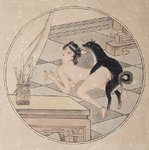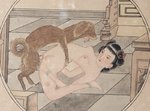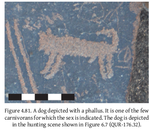M
Mickflare
Guest
Damn you beat me to the Roman history XDDoubt that advanced civilizations (like our modern one) could condone sexuality? You just haven't been using this site's resources. Use them!
Check out the "Articles & Blogs" sections. I've posted highlights from one of them found here:
Zoo Research and Data - Beetz & Podberscek (Eds.). (2005). Bestiality and zoophilia: Sexual relations with animals
Beetz, A. M., & Podberscek, A. L. (Eds.). (2005). Bestiality and zoophilia: Sexual relations with animals. West Lafayette, IN: Purdue University Press. Content: Seven contributions from academics and professionals consider the phenomenon of...www.zooville.org
Prehistoric Times
According to Rosenberger (1968), documentation of the practice of human–animal sex dates back to at least in the Fourth Glacial Age, between 40,000 and 25,000 years ago. Many discoveries of paintings and carvings showing humans and animals having sexual relations have been made in various ancient religious temples (Davis 1954), indicating the pre-occupation of ancient man with bestiality (Stekel 1952). For example, according to Taylor (1996), an engraved bone rod from the cave of La Madeleine, France, from the later Ice Ages (around 25,000 years ago), depicts a lioness licking the opening of either a gigantic human penis or a vulva, and an Iron Age cave painting from the seventh century BC, from Val Camonica, Italy, portrays a man inserting his penis into the vagina or anus of a donkey (Gregersen 1983; Taylor 1996). According to Waine (1968), cave drawings of the Stone Age leave no doubt that our prehistoric ancestors enjoyed frequent and pleasurable sexual relations with animals.
Moreover, the fact that these drawings had an integral part in a clan’s family history, indicates it was a common act (Waine 1968; Ellison 1970), or at least a desired act.
Ancient Near East
Archeological findings demonstrate that bestiality was practiced in Babylonia, the ancient Empire in Mesopotamia, which prospered in the third millennium BC. In his famous Code of Hammurabi, King Hammurabi (1955–1913 BC) proclaimed death for any person engaging in bestiality (Ellison 1970; Blake 1972; Hamilton 1981). At other times, according to Waine (1968), during the Spring Fertility Rites of Babylon, dogs and other animals were used for maintaining a constant orgy condition for seven days and nights (Waine 1968).
The Hittites, (around 13th century BC), the predecessors of the Hebrews in the Holy Land, had certain rules about which animals were tolerable to have sex with and which were forbidden and punishable by death (Gregersen 1983; Kinsey, Pomeroy and Martin 1948).
The Book of Leviticus states that bestiality was very wide-spread in the country of Canaan (Dubois-Desaulle 1933; Niemoeller 1946a). The Hebrews took issue with all the previous inhabitants of the Holy Land and their customs. Even depicting God with an animal’s head or an animal’s body was an abomination (Dekkers 1994). The Hebrews considered sexual relations with animals a form of worshiping other Gods, as was homosexuality, and the bestialist and the animal were both to be put to death.
The purpose of these taboos was to help maintain and reinforce the boundaries of the group, and enable it to retain its distinctive identity under adverse circumstances (Davies 1982).
There are four references concerning men who have sexual contacts with animals in the Old Testament (Exodus 22:19; Leviticus 18: 22–24; Leviticus 20: 15–16; Deuteronomy 27:21), and two references concerning women (Leviticus 18:23; Leviticus 20:16). The Talmud, a commentary on the Old Testament, specifically forbids a widow from keeping a pet dog, lest she be tempted to have sexual relations with it (Hunt 1974; Bullough 1976; Gregersen 1983; Dekkers 1994).
Ancient Egypt
The ancient Egyptians worshiped Gods with animal shapes almost exclusively in the pre-dynastic period before about 3000 BC (Douglas 1992). Animal–human sexual contacts are occasionally portrayed on the tombs (Bullough 1976), and bestiality was recorded in Egyptian hieroglyphics as far back as 3000 BC (Ramsis 1969). Several kings and queens had a reputation of engaging in bestiality (Rosenfeld 1967; Rosenberger 1968), most famous was Cleopatra, who was said to have had a box filled with bees which she had placed against her genitals for stimulation, similar to a vibrator (Love 1992).
Egyptian men often had sexual intercourse with cattle or any other large domesticated animal (Tannahill 1992), while the women resorted to dogs (Rosenfeld 1967; Rosenberger 1968). Sexual contacts with apes were further reported for both men and women (Masters 1962; Bagley 1968; Ramsis 1969), and most interestingly, the Egyptians are reported to have mastered the art of sexual congress with the crocodile. This was accomplished by turning the creature onto its back, rendering it incapable of resisting penetration. This form of copulation was believed to bring prosperity and restore the potency of men (Masters 1962; Bledsoe 1965; Maybury 1968; Kullinger 1969; Ramsis 1969; Love 1992). The Egyptians were also known to engage in worshipful bestiality with the Apis bull in Memphis, Egypt (The Wild Animal Revue 1992, Issue 5) and with goats at the Temple at Mendes (Mantegazza 1932; Bloch 1933; Niemoeller 1946a; Davis 1954; Masters 1962; Rosenfeld 1967; Bagley 1968; Maybury 1968; Love 1992). The goats were further used as a cure for nymphomaniacs (Masters 1962; Bagley 1968). Having said all that, bestiality was however, punishable in Egypt, by a variety of torture mechanisms, leading to death (Rosenfeld 1967; Rosenberger 1968; Trimble 1969).
Ancient Greece
Bestiality themes were very popular in Greek mythology (Kinsey et al. 1953; Masters 1962; Masters 1966; Rosenfeld 1967; Bagley 1968; Harris 1969; Haeberle 1978; The Wild Animal Revue 1991, Issue 1). Most notorious are the stories of Leda and the swan (Zeus), and Pasiphae, the wife of Minos, King of Crete, who fell in love with a bull, hid inside a wooden cow and copulated with it (Masters 1962; The Wild Animal Revue 1991, Issue 1; Dekkers 1994). The worship of bulls as fertility symbols was widespread in Crete and elsewhere long before the Greek period in classical times, and the tone of the writers of the day leaves no room to doubt that bestiality was a fairly common occurrence in daily life (Niemoeller 1946a).
The ancient Greeks engaged in bestiality during religious celebrations such as the Bacchanalia, in honor of the God Bacchus (Dubois-Desaulle 1933), and in the Temple of Aphrodite Parne, the Greek Goddess of Indecent Copulation (Waine 1968). As with the ancient Egyptians, ancient Greeks believed bestiality cured nymphomaniacs (Masters 1962; Bagley 1968). Bestial affairs were acted out on the Greek stage (Masters 1966), and were the theme of The Golden Ass by Lucius Apuleius, the earliest Latin novel that has remained in its entirety, and has long been censored because of its pornographic language and bestiality content (Ramsis 1969). Bestiality was never punishable in ancient Greece (Rosenberger 1968).
Ancient Rome
Roman mythology is rich with bestiality themes (Kinsey et al. 1953; Harris 1969), as is Greek mythology, and the Romans liked to view on stage scenes from the sexual lives of the mythological Gods, including bestial acts (Masters 1962; Bagley 1968; The Wild Animal Revue 1992, Issue 5). Bestiality was wide-spread among shepherds (Masters 1962), and Roman women were known to keep snakes which they trained to coil around their thighs and slide past the lips of their vaginas (Davis 1954; Masters 1962; Christy 1967; Maybury 1968; Dekkers 1994).
It was the Romans who invented the rape of women (and sometimes men) by animals for the amusement of the audience at the Coliseum and Circus Maximus, and bestiality flourished as a public spectacle in ancient Rome (Masters 1962; Bledsoe 1965; Somers 1966; Rosenfeld 1967; Rosenberger 1968; Waine 1968; Harris 1969; Trimble 1969; Blake 1972; Love 1992; The Wild Animal Revue 1992, Issue 5; Dekkers 1994).
Emperors, such as Tiberius (AD 14–37), his wife Julia, Claudius (AD 37–41), Nero (AD 54–68), Constantinus (a.k.a. Constantine the Great, AD 274–337), Theodora (Emperor Justinian’s wife, AD 520s), and Empress Irene (AD 797–802), had been known to either engage in bestiality or enjoy watching others engage in bestiality (Bledsoe 1964; Rosenfeld 1967; Rosenberger 1968; Waine 1968; Blake 1972; Hamilton 1981; Love 1992; The Wild Animal Revue 1992, Issue 5). According to Niemoeller (1946a), at the beginning of the Roman Empire, legal retribution for bestiality was required only for sodomy, under which bestiality was included. Later, bestiality was distinguished from sodomy and made punishable by death (Dubois-Desaulle 1933; Niemoeller 1946b). In any event, as the Empire expanded and grew more powerful and corrupt, punishments for bestiality became almost nonexistent (Rosenberger 1968).






